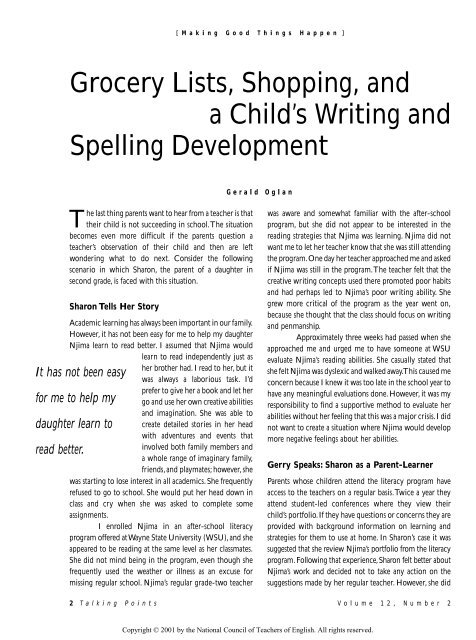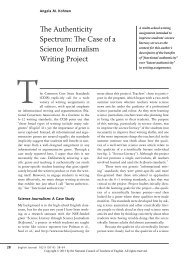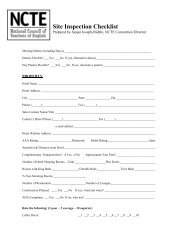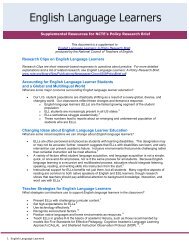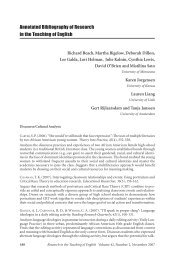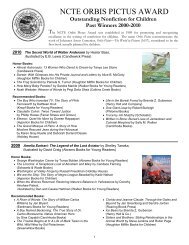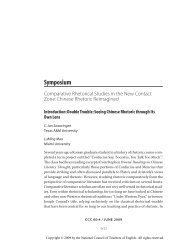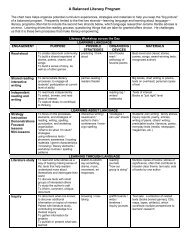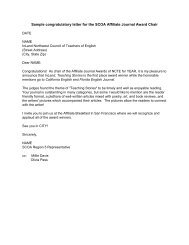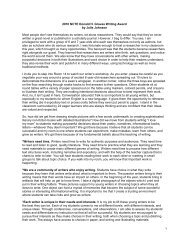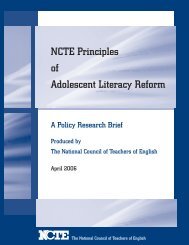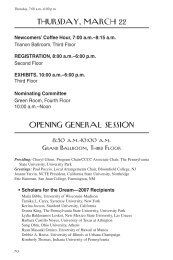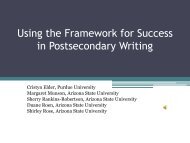Grocery Lists, Shopping, and a Child's Writing and Spelling ...
Grocery Lists, Shopping, and a Child's Writing and Spelling ...
Grocery Lists, Shopping, and a Child's Writing and Spelling ...
Create successful ePaper yourself
Turn your PDF publications into a flip-book with our unique Google optimized e-Paper software.
[ Making Good Things Happen ]Figure 4. Njima’s grocery list from week three.Figure 3. Njima’s week-two list.[4.] RepresentationsStudents sometimes know that a vowel isneeded but insert a r<strong>and</strong>om vowel, e.g., misery/maziry, sometime/semtim.[5.] OvergeneralizationsWhen students discover a new structure such asthe silent e at the end of words, they use itexclusively, e.g., won/wone, from/frome.[6.] TranspositionalWords are spelled using all of the correct lettersbut in the wrong order, e.g., tried/tride, watch/wacht.[7.] VisualWords have a visual likeness to the conventionalform, e.g., school/scool, teacher/techer.[8.] ArticulationVowels <strong>and</strong> consonants are close in sound <strong>and</strong>are usually used interchangeably, e.g., combat/kombat, graphics/grafics.[9.] One-letter missesThe word is close to the conventional formwith the exception of a letter, e.g., snowed/snowd, waiting/wating.[10.] Multiple strategiesCombinations of the strategies, e.g., neighborhood/nebrhode,retirement/ritearment.Across the four weeks of Njima’s list-making, we canidentify examples of developmentally appropriate spellingstrategies. She used letter name strategies on hamburger/hmbgr, lemon/lmn, butter/btr, sugar/sgr, tart/trt, <strong>and</strong> white/wt.She employed the placeholder strategy on bun/bon <strong>and</strong>pizza/pezza, <strong>and</strong> had one-letter misses on lemon/lmon,black/blak, bread/bred. In words like pepper/pepr, with a4 Talking Points Volume 12, Number 2
[ Making Good Things Happen]In Figure 2 we see a reversal on the g in sugar <strong>and</strong> the e in theword egg. In Figure 5 reversals appear on the r in grass <strong>and</strong> thes in seed. Learning to write letters <strong>and</strong> numbers correctlyinvolves three components: knowing the configuration(shape) of the character, knowing that directionality (left toright, top to bottom) matters, <strong>and</strong>knowing the direction a particularcharacter faces (Wilde, 1992). Njimahas a grasp of the first two of these,<strong>and</strong> only the third remains to be teachers holdfirmly established. However, we seein other words (Figure 5) thatdirection is established on the letters in the word eggs <strong>and</strong> r in the wordbread. The reversals may have occurredsimply because Njima wasconcentrating on other things whiledilemma.writing. The reversals should not betaken as a sign of dyslexia but as a sign that Njima is usingwhat she knows about spelling <strong>and</strong> writing in an attempt towrite her list.When parents <strong>and</strong>conflicting beliefs,the parents face aTeacher BeliefsFigure 5. Njima’s fourth-week list.double consonant, often one consonant will be left outbecause only one is heard. The vocalic “r” blends in pepper/pepr <strong>and</strong> paper/papr are initially represented with only the rsince it is the only sound heard. Other strategies Njima usedinclude a one-letter miss on olive/oliv; transpositional strategyon oil/oli; sounding out on bottle/btol, plate/plaet, cool aid/clad; <strong>and</strong> an articulation strategy on fish/fshe. It is interestingto note that the word lemon was spelled using a letter-namestrategy in week one (lmn), using a one-letter miss in weektwo, <strong>and</strong> finally spelled conventionally in week four.Njima’s regular teacher told Sharon that sheshould have Njima checked for dyslexia. Perhaps the regularteacher was concerned by the reversals in Njima’s writing.When parents <strong>and</strong> teachers hold conflicting beliefs, theparents face a dilemma. The advice from Njima’s classroomteacher was rooted in her beliefs about learning <strong>and</strong>effective teaching (Mills & Clyde, 1991). Harste <strong>and</strong> Burke(1980) found, by looking at the literacy experiencesprovided by teachers, that theory underpins a teacher’scurricular decisions. Deford <strong>and</strong> Harste (1982) found thatchildren from classrooms where basal readers were usedproduce written text similar in content <strong>and</strong> form to thepublished materials. Even though the decisions made reflectteachers’ best intentions, not all belief systems are of equalbenefit to learners (Harste, Woodward, & Burke, 1984).SummarySharon’s story is not unusual. When parents are concernedabout their children’s learning, they often turn to teachersfor guidance <strong>and</strong> advice. In Njima’s case Sharon refused tofollow-up on the suggestion that her child be tested fordyslexia. Instead she took it upon herself to learn moreabout her daughter <strong>and</strong> about strategies that could help herat home. The WSU Literacy Center supported Sharon byallowing her to view Njima’s work in the center <strong>and</strong> byApril/May 2001 Talking Points 5
[ Making Good Things Happen ]working with her on strategies she could try at home. Thiswas a risk for Sharon. She indicated in her story at thebeginning that she found it difficult to incorporate thelearning strategies into their home life. Sharon had to workthrough her own fears while at the same time finding a wayto help her daughter feel more comfortable about reading,writing, <strong>and</strong> spelling. Ideally, schools should take theinitiative by providing opportunities for parents to engagein their own learning (Oglan, 1997). In doing so, schools<strong>and</strong> parents can work together within a collaborative modelto address the literacy needs of both parents <strong>and</strong> theirchildren.ReferencesBean, W., & Bouffler, C. (1987). Spell by writing. Maryborough,Australia: Primary English Teaching Association.Deford, D. E., & Harste, J. C. (1982). Child language research<strong>and</strong> curriculums. Language Arts, 59 (6), 590-600.Harste, J. C., & Burke, C. L. (1980). Examining instructionalassumptions: The child as informant. Theory intoPractice, 19, 170-178.Harste, J.C., Woodward, V.A., & Burke, C.L. (1984).Language stories <strong>and</strong> literacy lessons. Portsmouth, NH:Heinemann.Mills, H., & Clyde, J. A. (Eds). (1990). Portraits of wholelanguage classrooms: Learning for all ages. Portsmouth,NH: Heinemann.Oglan, G.R. (1997). Parents learning <strong>and</strong> whole languageclassrooms. Urbana, IL: NCTE.Wilde, S. (1992). You kan read this: <strong>Spelling</strong> <strong>and</strong> punctuationfor whole language classrooms, K–6. Portsmouth, NH:Heinemann.Gerry Oglan is the current president of WLU.TylerGlasses <strong>and</strong> kindness, squirrelly to a fault.What makes Tyler struggle so to write?Has two desks ’cause stuff is too distracting.What makes Tyler struggle so to write?Fought with Nick.Argued with Austin.Now he starts with Dustin.What makes Tyler struggle so to write?Eager with a hug.First to find a job.Truly aims to please.What makes Tyler struggle so to write?His h<strong>and</strong>writing is atrocious.Says his h<strong>and</strong> hurts when he writes.Maybe that’s why Tyler struggles so to write.Got him a keyboard to keep his h<strong>and</strong>s from hurtingOhhnnnno, Tyler’s got a new toy. . . .Why does Tyler struggle so to write?—Sharon FloydSharon Floyd teaches at Union Ridge Elementary School in Ridgefield, WA.6 Talking Points Volume 12, Number 2


